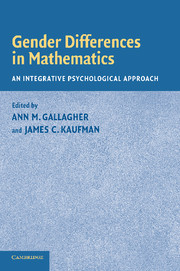Book contents
- Frontmatter
- Contents
- Preface
- Acknowledgments
- List of Contributors
- 1 Research on the Women and Mathematics Issue: A Personal Case History
- 2 The Perseverative Search for Sex Differences in Mathematics Ability
- 3 A Psychobiosocial Model: Why Females Are Sometimes Greater Than and Sometimes Less Than Males in Math Achievement
- 4 Gender Differences in Math: Cognitive Processes in an Expanded Framework
- 5 Cognitive Contributions to Sex Differences in Math Performance
- 6 Spatial Ability as a Mediator of Gender Differences on Mathematics Tests: A Biological–Environmental Framework
- 7 Examining Gender-Related Differential Item Functioning Using Insights from Psychometric and Multicontext Theory
- 8 The Gender-Gap Artifact: Women's Underperformance in Quantitative Domains Through the Lens of Stereotype Threat
- 9 “Math is hard!” (Barbie™, 1994): Responses of Threat vs. Challenge-Mediated Arousal to Stereotypes Alleging Intellectual Inferiority
- 10 The Role of Ethnicity on the Gender Gap in Mathematics
- 11 The Gender Gap in Mathematics: Merely a Step Function?
- 12 “I can, but I don't want to”: The Impact of Parents, Interests, and Activities on Gender Differences in Math
- 13 Gender Effects on Mathematics Achievement: Mediating Role of State and Trait Self-Regulation
- 14 Gender Differences in Mathematics Self-Efficacy Beliefs
- 15 Gender Differences in Mathematics: What We Know and What We Need to Know
- Author Index
- Subject Index
- References
13 - Gender Effects on Mathematics Achievement: Mediating Role of State and Trait Self-Regulation
Published online by Cambridge University Press: 05 June 2012
- Frontmatter
- Contents
- Preface
- Acknowledgments
- List of Contributors
- 1 Research on the Women and Mathematics Issue: A Personal Case History
- 2 The Perseverative Search for Sex Differences in Mathematics Ability
- 3 A Psychobiosocial Model: Why Females Are Sometimes Greater Than and Sometimes Less Than Males in Math Achievement
- 4 Gender Differences in Math: Cognitive Processes in an Expanded Framework
- 5 Cognitive Contributions to Sex Differences in Math Performance
- 6 Spatial Ability as a Mediator of Gender Differences on Mathematics Tests: A Biological–Environmental Framework
- 7 Examining Gender-Related Differential Item Functioning Using Insights from Psychometric and Multicontext Theory
- 8 The Gender-Gap Artifact: Women's Underperformance in Quantitative Domains Through the Lens of Stereotype Threat
- 9 “Math is hard!” (Barbie™, 1994): Responses of Threat vs. Challenge-Mediated Arousal to Stereotypes Alleging Intellectual Inferiority
- 10 The Role of Ethnicity on the Gender Gap in Mathematics
- 11 The Gender Gap in Mathematics: Merely a Step Function?
- 12 “I can, but I don't want to”: The Impact of Parents, Interests, and Activities on Gender Differences in Math
- 13 Gender Effects on Mathematics Achievement: Mediating Role of State and Trait Self-Regulation
- 14 Gender Differences in Mathematics Self-Efficacy Beliefs
- 15 Gender Differences in Mathematics: What We Know and What We Need to Know
- Author Index
- Subject Index
- References
Summary
Gender differences in achievement have been the focus of many studies across different domains (e.g., Halpern, 2000; Willingham & Cole, 1997). Mathematics especially has received much attention due to its fundamental importance in modern society, its observed performance gap in favor of males on many academic tasks, and its minority of female experts in related fields (Halpern, 2000). Other chapters in this book provide a discussion of possible reasons for these gender differences in mathematics (e.g., critical thinking, biopsychosocial reasons, spatial ability, talent, personality). The focus of this chapter is on the role of self-regulation.
In a general sense, self-regulation is any effort to alter or sustain one's own pattern of behavior (Baumeister, Heatherton, & Tice, 1994). Within the academic context, however, self-regulated learning has been characterized by motivational, cognitive, and metacognitive strategies that specifically facilitate academic achievement (Bandura, 1993; McCombs, 1984). We explore mediating roles of students' trait and state self-regulation in academic tasks and of students' test anxiety to further our understanding of the gender gap in students' mathematics achievement.
Traits are considered relatively enduring predispositions or characteristics of people (e.g., intelligence, aptitude, or self-regulation), whereas states are attributes of individuals that are relatively changeable, thus representing dimensions of intraindividual variability over time or occasions (Spielberger, 1975). The distinction is important because individuals' traits are highly predictive of their state characteristics, although manifestations of state characteristics are highly dependent on the environment and circumstances of the specific instance.
- Type
- Chapter
- Information
- Gender Differences in MathematicsAn Integrative Psychological Approach, pp. 264 - 293Publisher: Cambridge University PressPrint publication year: 2004
References
- 1
- Cited by



